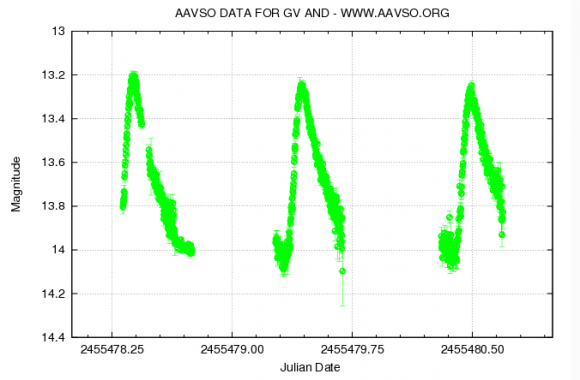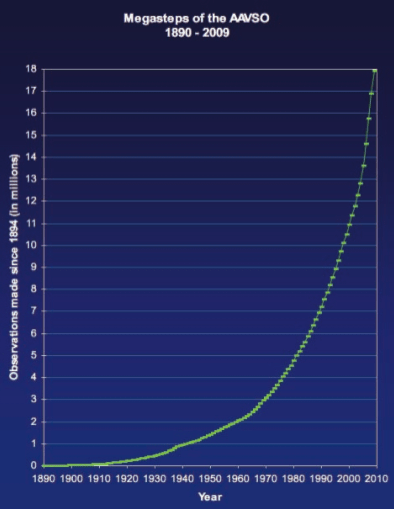[/caption]Early into the celebration of its centennial year, observers of the American Association of Variable Star Observers (AAVSO) passed another milestone over the weekend, when an amateur astronomer from Belgium contributed the 20 millionth observation of a variable star on February 19, 2011.
Amateur astronomers have been recording changes in the brightness of stars for centuries. The world’s largest database is run by the AAVSO. Started in 1911, it is one of the oldest, continuously operating citizen science projects in the world.
“The long-term study of stellar brightness variation is critical to understanding how stars work and the impact they have on their surroundings. The noble efforts of the engaged AAVSO volunteers play an important role in astronomy and help expand human knowledge,” said Dr. Kevin Marvel, Executive Officer of the American Astronomical Society.
The AAVSO currently receives variable star brightness estimates from about 1,000 amateur astronomers per year. Some variable stars are bright enough to be seen with the unaided eye while others require high-tech equipment. The AAVSO also has a network of robotic telescopes available to members free of charge.
“Because some variable stars are unpredictable and/or change their brightness over long time scales, it is not practical for professional astronomers to watch them every night. Thus, amateurs were recruited to keep tabs on these stars on behalf of professionals,” Dr. Arne Henden, Director of the AAVSO, said.
The 20 millionth observation was made by Dr. Franz-Josef “Josch” Hambsch of Belgium. The observation was of GV Andromeda, member of a class of older, pulsating stars smaller than our Sun. “I like these stars because you can see their entire variation cycle in one night. There have not been many recent observations made of this particular star, so that is why I am monitoring it,” Hambsch said. Hambsch is also a member of the Belgian variable star organization, Vereniging Voor Sterrenkunde, Werkgroep Veranderlijke Sterren (VVS, WVS).

The process of estimating a star’s brightness can range from less than a minute to many hours per estimate, but typically takes about five minutes. At that rate, observers have invested the equivalent of about 1.67 million hours of time in collecting observations for the database. Assuming a current median salary of US$33,000, this would be the roughly equivalent to 27.5 million dollars worth of donated time if all the observations were reported today.
“The reality is these observations are invaluable. The database spans many generations and includes data that cannot be reproduced elsewhere. If an astronomer wants to know the history of a particular star, they come to the AAVSO,” Henden said.
The AAVSO’s mission is to coordinate, collect, and distribute variable star data to support scientific research and education. The AAVSO International Database is openly available to the public through their web site (www.aavso.org), where it is queried hundreds of times per day.


Wow. And I have only contributed just 243 observation or just 0.001215%. Guess the AAVSO would owe me just $334.13. (My time estimation would be 730 minutes or just 12.2 hours)
Had so much fun, and learn much, I guess I’ve already go my monies worth already! If the truth be known, I probably owe the AAVSO instead a couple of hundred dollars, for all the charts and great advice!
Are the raw numbers used for the first graph available? It looks sorta exponential, so I’d like to set my kids on fitting the data when we get to that function in a coupla months.